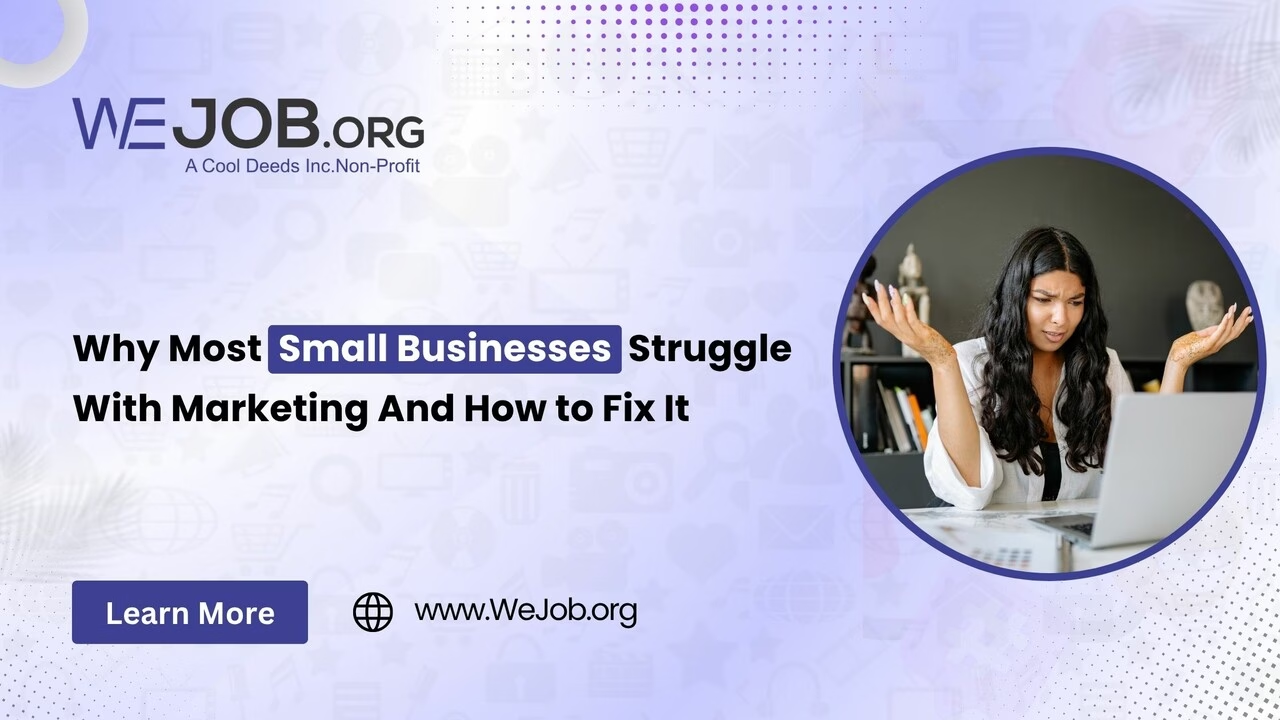Subtotal $0.00
Running a business is tough, marketing it is even tougher.
From tight budgets and lack of expertise to digital noise and inconsistent branding, small businesses often find themselves lost in the crowd. But the truth is, even today’s biggest brands once faced the same struggles. The difference? They adapted, evolved, and invested smartly in visibility, technology, and customer experience.
Let’s break down why small businesses struggle with marketing, and more importantly, how to fix it.
1. The Budget Dilemma: Big Dreams, Small Wallets
One of the most common challenges small businesses face is limited marketing budgets. When funds are tight, marketing often takes a backseat to operations, inventory, or staffing.
But here’s the catch: without visibility, there’s no growth.
Startups like Spotify once faced the same conundrum. Initially, the company struggled to gain traction due to limited awareness and trust in the streaming model. Their breakthrough? A freemium strategy, influencer partnerships, and smart branding that didn’t require massive ad spend.
Fix: Focus on value-driven, affordable strategies like content marketing, SEO, and social media. These channels offer organic growth with long-term results.
2. Lack of Direction: Throwing Darts in the Dark
Many small businesses start promoting their services without a clear plan, posting sporadically, copying competitors, or relying solely on word-of-mouth. This inconsistency not only confuses potential customers but also weakens the brand.
Even tech giants like Google didn’t become a household name overnight. It took years of refining their offering, establishing a strong brand voice, and investing in clear, user-centric marketing to build the empire they are today.
Fix: Build a marketing roadmap. Know who your audience is, what platforms they use, what problems they face, and how your product or service solves them.
3. No Unique Voice or Brand Identity
In a saturated digital world, blending in is the fastest way to disappear. A lack of branding, poor logos, generic messaging, and no clear voice, makes customers forget you the moment they scroll past.
Take Airbnb, for instance. In its early days, the brand struggled to stand out. But when they revamped their identity with the “Belong Anywhere” campaign, paired with simple UX and strong visuals, they skyrocketed to global success.
Fix: Invest in your visual and brand identity, a clean logo, consistent design, and authentic voice. These elements build trust and recall.
What Small Businesses Can Learn From Big Brand Struggles
1- Spotify:
In 2008, Spotify launched in a world dominated by iTunes and illegal downloading (hello, LimeWire). Their idea? A free streaming platform with ads or a paid subscription, a model that didn’t exist at scale.
The problem?
- People didn’t understand the value of “streaming”.
- Artists feared revenue loss.
- Spotify had no brand recognition outside Scandinavia.
What They Did Right:
- Freemium Model: Instead of forcing people to pay upfront, Spotify gave access for free, then nudged users into premium with benefits like offline listening and no ads.
- Exclusive Launch: They created invite-only access, which sparked intrigue and demand.
- Partnerships: Collaborated with Facebook early on to integrate music sharing, tapping into a global social network for free word-of-mouth marketing.
- Data-Driven Personalization: “Discover Weekly” and curated playlists changed how users interacted with the app and made it stickier.
Lesson for Small Businesses:
- Educate your audience on your offering, especially if it’s new.
- Create low-risk entry points (like free trials or freemium models).
- Use existing platforms (like social media or partnerships) to extend your reach.
2- Google:
When Google launched in 1998, it entered a saturated market. Yahoo, MSN, and AltaVista were dominant. Google had no flashy homepage, no ads, no directory listings, just a plain search box.
The problem?
- Minimalism was misunderstood as “unfinished.”
- They had no immediate monetization model.
- Big players had already won user loyalty.
What They Did Right:
- Clarity Over Clutter: Google didn’t chase trends. They focused on delivering relevant results faster and cleaner.
- Built Trust: Their algorithm delivered accuracy that competitors lacked. Word spread organically.
- Invented AdWords: They later introduced a powerful PPC model, allowing even small businesses to advertise effectively with limited budgets.
Lesson for Small Businesses:
- Don’t just copy trends, solve problems better than anyone else.
- Trust builds long-term brand loyalty.
- Think about monetization, but focus on delivering value first.
Airbnb:
In 2008, Airbnb’s concept, renting your home to strangers, sounded bizarre, even dangerous. Founders Brian Chesky and Joe Gebbia struggled to gain users, funding, and most importantly trust.
The problem?
- People were scared to host or stay with strangers.
- Hotels dominated travel, with credibility.
- Early website had poor UX and low-quality images.
What They Did Right:
- Photo Upgrades: They hired professional photographers to make listings feel premium.
- Storytelling & Community: Airbnb shifted the message from “cheap stay” to “belonging anywhere.”
- Design-Centric Branding: From the logo to the app UI, everything became human-centered and emotionally appealing.
Lesson for Small Businesses:
- Visuals matter, invest in how your brand looks and feels.
- Tell stories that connect with your audience’s emotions.
- Reinvent your message if your first one doesn’t land.
- Airbnb couldn’t compete with hotels, until they told better stories.
Their success wasn’t luck, it was strategy, consistency, and branding.
The One-Stop Solution for Small Business Growth: WeJob.org
If you’re a business owner overwhelmed by marketing, tech, and branding, WeJob.org is here to change that.
We offer complete, affordable packages tailored for small businesses, including:
- 🔹 Business Branding (Logo, Brand Guidelines, Storytelling)
- 🔹 Online Visibility (SEO, Social Media, Google Optimization)
- 🔹 Custom Website & Mobile App Development
- 🔹 Professional Graphic Design & Visual Content
All at meager prices, because we know what it’s like to start small.
Don’t Let a Limited Budget Hold You Back.
Try our 7-day free trial, or schedule a free consultation today at WeJob.org/#book-an-appointment to discover what’s possible for your business growth.

